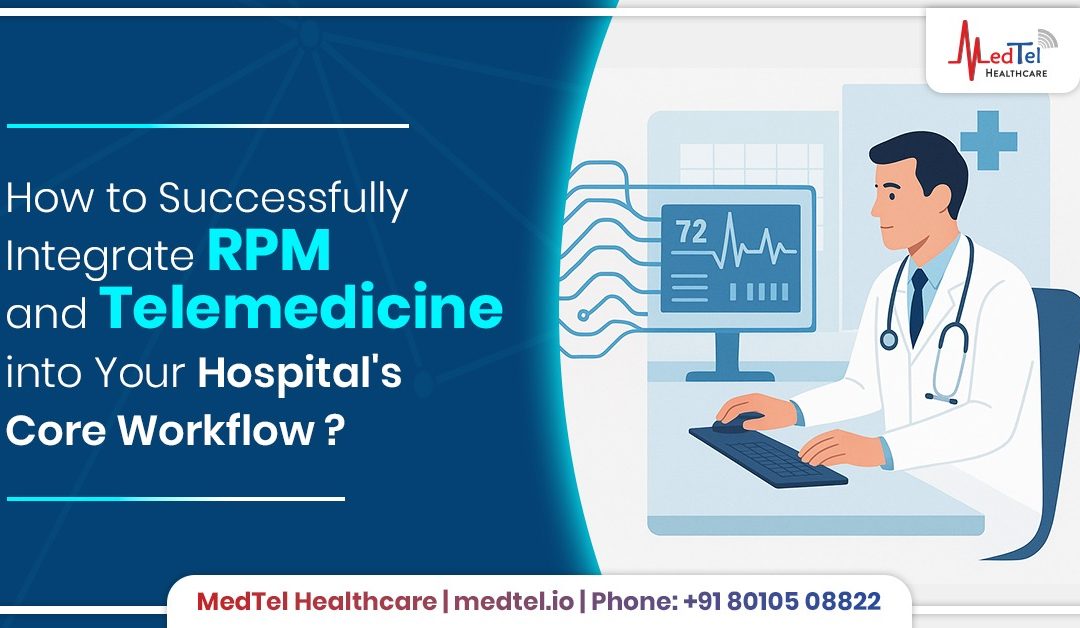The biggest barrier to digital health success isn’t the technology—it’s operational integration. Too often, Remote Patient Monitoring (RPM) and Telemedicine are run as separate pilot projects that never scale. To achieve lasting transformation, you must weave virtual care seamlessly into your existing daily routines. The goal is to make virtual care the new Standard Operating Procedure (SOP).
1. Eliminate the Digital Silo 🚫
Don’t create a separate “Telemedicine Department” that operates outside the core hospital infrastructure.
The Integration Mandate:
- Embed, Don’t Annex: Instead of building a new center, integrate virtual services into high-volume specialty clinics like Cardiology, Diabetology, and Post-Operative Care.
- Default Follow-Up: Make virtual check-ups the default follow-up mechanism for stable, low-risk, or post-operative patients. This automatically shifts volume from the crowded Outpatient Department (OPD) to the virtual setting, maximizing clinic space for new or complex cases.
- Cross-Train Leadership: Appoint a “Digital Lead” within each key specialty (a senior nurse or physician) who champions the technology and ensures its local workflow adoption.
2. Re-engineer the Patient Digital Journey 🗺️
Success starts with mapping the patient’s interaction from the moment they need care to their virtual follow-up.
A. Seamless Onboarding and Consent
- Automated Enrollment: Use your Hospital Management Information System (HMIS) to flag eligible patients for RPM/Telemedicine enrollment (e.g., those with chronic conditions).
- Device Provisioning (for RPM): Implement a clear logistics system for mailing, receiving, and cleaning IoT devices (like Bluetooth BP cuffs and glucometers).
- Pre-Consult Consent: Obtain explicit, digital consent for data collection, sharing (in line with ABDM standards), and virtual consultation before the first digital appointment.
B. Smart Triage and Alert Management
- Dashboard View: Equip your care team with a unified dashboard that aggregates patient data (vitals, symptoms) from RPM devices.
- Color-Coded Alerts: Implement clear, automated alerting protocols (e.g., Green for routine, Yellow for follow-up needed, Red for immediate intervention). This is critical for preventing alert fatigue.
- Protocolized Action: Define the exact staff action for each alert level (e.g., a Red alert mandates a nurse call within 10 minutes and physician notification).
3. EHR Integration is Non-Negotiable 💾
Without real-time data flow, Telemedicine creates data fragmentation, which is dangerous and inefficient.
- Bi-Directional Sync: Ensure the virtual consultation platform is fully integrated with your EHR/HMIS. The doctor shouldn’t have to manually copy notes or prescriptions.
- Auto-Populate Records: Consultation notes, e-prescriptions, lab requests, and diagnosis codes must flow automatically back into the patient’s digital file.
- ABHA Linkage: Structure your system to easily link the digital records generated to the patient’s Ayushman Bharat Health Account (ABHA) ID, ensuring compliance and data portability.
4. Empower the Frontline Staff 💪
The most significant integration challenge is often staff resistance or lack of confidence.
- Targeted Training: Provide focused training based on role:
- Nurses: Focus on RPM dashboard management, patient education on devices, and alert triage.
- Front Office: Focus on virtual scheduling, payment processing, and troubleshooting basic patient connectivity issues.
- Physicians: Focus on utilizing the pre-consult data summary and maintaining the proper medico-legal documentation during the virtual visit.
- The Digital Champion Model: Designate, empower, and reward internal “Digital Champions” within nursing and front desk teams to provide peer-to-peer support and reduce technical reliance on the central IT department.
5. Align Revenue and Inventory 💰
Scale requires a sustainable business model where digital care pays for itself and is treated as a high-value service.
- RCM Integration: Incorporate virtual care billing seamlessly into your Revenue Cycle Management (RCM) system. Define specific service codes for different virtual services to ensure accurate and timely reimbursement (crucial for government and private insurance claims).
- Subscription Models: Shift from one-time consultation fees to subscription-based RPM services. This creates predictable, recurring revenue while ensuring continuous patient engagement.
- Device Asset Management: Treat RPM devices as circulating assets. Implement a tracking and maintenance protocol for device sterilization, calibration, and redeployment to maintain a high ROI and guarantee patient safety
Successful integration isn’t about deploying technology; it’s about transforming the people and processes that deliver care. By focusing on workflow re-engineering and staff empowerment, your hospital can move beyond the pilot and achieve true digital resilience.
